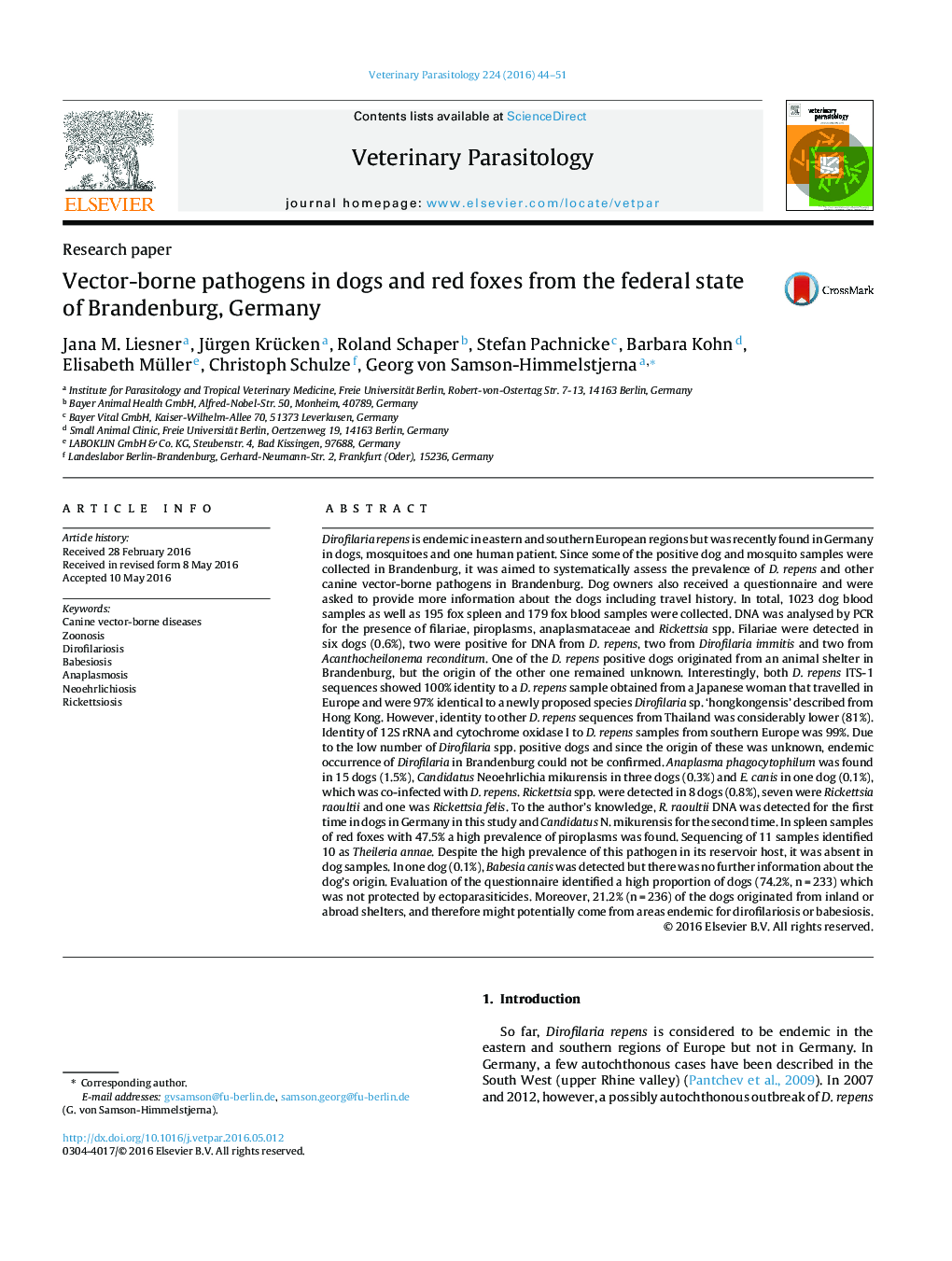| کد مقاله | کد نشریه | سال انتشار | مقاله انگلیسی | نسخه تمام متن |
|---|---|---|---|---|
| 2469819 | 1555652 | 2016 | 8 صفحه PDF | دانلود رایگان |
• About 1000 blood and 200 fox samples collected in Brandenburg, Germany during 2013 and 2014.
• Only very small numbers of dogs samples Dirofilaria-positive (n = 2 for both species).
• First cases of Rickettsia raoulti infected dogs described
• Two dogs positive for Candidatus Neoehrlichia mikurensis representing only 2nd detection in dogs.
• Theileria annae found in more than 45% of the fox samples while absent in all examined dogs.
Dirofilaria repens is endemic in eastern and southern European regions but was recently found in Germany in dogs, mosquitoes and one human patient. Since some of the positive dog and mosquito samples were collected in Brandenburg, it was aimed to systematically assess the prevalence of D. repens and other canine vector-borne pathogens in Brandenburg. Dog owners also received a questionnaire and were asked to provide more information about the dogs including travel history. In total, 1023 dog blood samples as well as 195 fox spleen and 179 fox blood samples were collected. DNA was analysed by PCR for the presence of filariae, piroplasms, anaplasmataceae and Rickettsia spp. Filariae were detected in six dogs (0.6%), two were positive for DNA from D. repens, two from Dirofilaria immitis and two from Acanthocheilonema reconditum. One of the D. repens positive dogs originated from an animal shelter in Brandenburg, but the origin of the other one remained unknown. Interestingly, both D. repens ITS-1 sequences showed 100% identity to a D. repens sample obtained from a Japanese woman that travelled in Europe and were 97% identical to a newly proposed species Dirofilaria sp. ‘hongkongensis’ described from Hong Kong. However, identity to other D. repens sequences from Thailand was considerably lower (81%). Identity of 12S rRNA and cytochrome oxidase I to D. repens samples from southern Europe was 99%. Due to the low number of Dirofilaria spp. positive dogs and since the origin of these was unknown, endemic occurrence of Dirofilaria in Brandenburg could not be confirmed. Anaplasma phagocytophilum was found in 15 dogs (1.5%), Candidatus Neoehrlichia mikurensis in three dogs (0.3%) and E. canis in one dog (0.1%), which was co-infected with D. repens. Rickettsia spp. were detected in 8 dogs (0.8%), seven were Rickettsia raoultii and one was Rickettsia felis. To the author’s knowledge, R. raoultii DNA was detected for the first time in dogs in Germany in this study and Candidatus N. mikurensis for the second time. In spleen samples of red foxes with 47.5% a high prevalence of piroplasms was found. Sequencing of 11 samples identified 10 as Theileria annae. Despite the high prevalence of this pathogen in its reservoir host, it was absent in dog samples. In one dog (0.1%), Babesia canis was detected but there was no further information about the dog’s origin. Evaluation of the questionnaire identified a high proportion of dogs (74.2%, n = 233) which was not protected by ectoparasiticides. Moreover, 21.2% (n = 236) of the dogs originated from inland or abroad shelters, and therefore might potentially come from areas endemic for dirofilariosis or babesiosis.
Journal: Veterinary Parasitology - Volume 224, 15 July 2016, Pages 44–51
